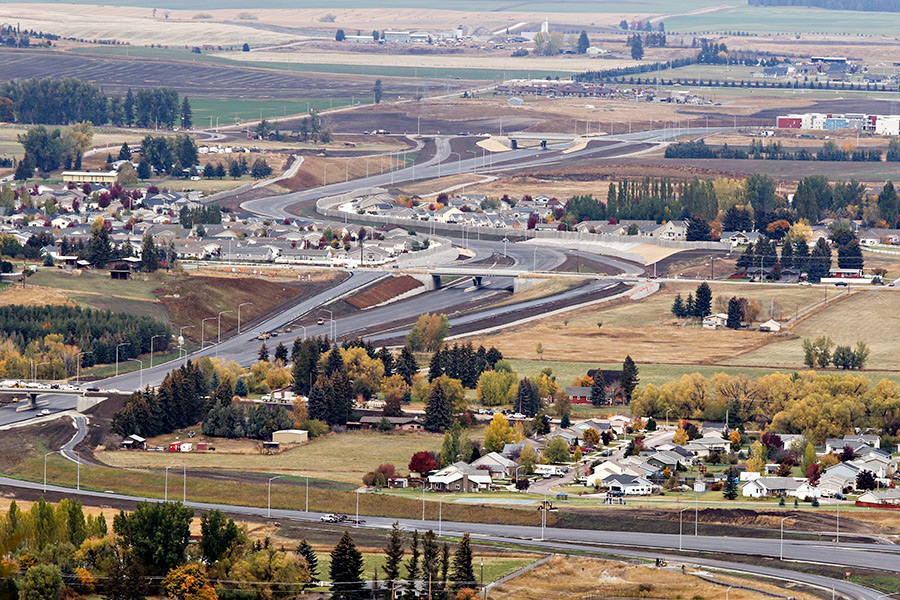The far-reaching influence of the Kalispell bypass continues to come into focus as residential and commercial development flourishes along the 7-mile roadway.
A new economic analysis, conducted by a transportation authority and an economist, of the massive project is further illustrating the extent of its benefits and punctuating the impact of infrastructure investment.
According to the report, the total economic impact of the U.S. Highway 93 Alternate Route exceeded $1 billion over the life of the project’s construction, which spanned 16 years from 2001 to last fall.
The new highway reshaped the landscape in many ways, particularly on the north end of Kalispell, and the report shows that three major job sectors benefited most from its creation: retail trade (1,477 new jobs), dining (489) and services (490).
From 2001 to 2016, roughly 2 million square feet of new building space surfaced along the bypass route, worth roughly $140 million in project costs, according to city of Kalispell data cited in the report. That new construction investment does not include Glacier High School or expansion projects at Flathead Valley Community College and Kalispell Regional Healthcare.
Ed Toavs, a Columbia Falls native and regional administrator for the Montana Department of Transportation who helped spearhead the bypass construction, conducted the economic analysis with Steve Peterson, an economics professor at the University of Idaho who specializes in economic impact studies.
As part of his Master of Business Administration program at the University of Idaho, Toavs decided to study the ripple effects of the bypass to better understand how it played a role in the Flathead Valley’s economy.
To grasp the breadth of the impact, Toavs gathered data for three factors: the $135 million in state and federal funds that built the bypass; the investment from new business and residential projects along the bypass corridor; and business wages, expenditures and earnings for those new developments.
Toavs said he used a conservative approach when calculating the direct financial benefits. For new construction investments, he included 65 percent of the overall figures in his economic impact report. For the amount of jobs, wages and earnings that likely resulted from new development along the bypass, Toavs included 33 percent of the total figures.
“We really wanted to have a conservative approach to ensure it’s defensible, and I think it is defensible,” Toavs said. “People can see all the buildings going up. You can see the results.”
»»» Click here to read the economic impact report
The bypass has also led to ancillary benefits, such as heightened revenues on school trust land, where businesses such as Costco, Hobby Lobby and others in the Spring Prairie Development are located.
The one-square-mile section of school trust land generated $18.8 million for Montana’s school coffers from 2001 to 2016.
“A project like this for anyone is a once-in-a-career project,” Toavs said. “To have it in my hometown where I grew up is even better.”
Talk of building a bypass in Kalispell dates back to the 1940s, when the valley was growing and Main Street was increasingly clogged with heavy traffic. It wasn’t until federal funds earmarked by Montana Sen. Max Baucus jumpstarted the acquisition of properties along the proposed route that it actually began surfacing.
Kalispell Bypass By the Numbers
$135 million: Cost to build the U.S. 93 Alternate Route from 2001-2016
$120 million: Portion of the cost to build the bypass that was funded by federal government dollars
$75.6 million: Average annual sales, or gross economic impact, resulting from the bypass, according to an economic analysis of the project that factored private business and residential construction in the bypass corridor
$1.12 billion: Overall gross economic impact of the construction of the bypass from 2001-2016, including new residential and commercial development and associated wages and sales, according to an economic analysis
760 jobs: Average annual number of jobs resulting from the construction of the bypass over the last 16 years, including construction crews and employees of new firms and businesses in the bypass corridor
Source: Economic analysis report completed by Ed Toavs with Montana Department of Transportation and Steve Peterson, clinical assistant professor in economics at the University of Idaho
